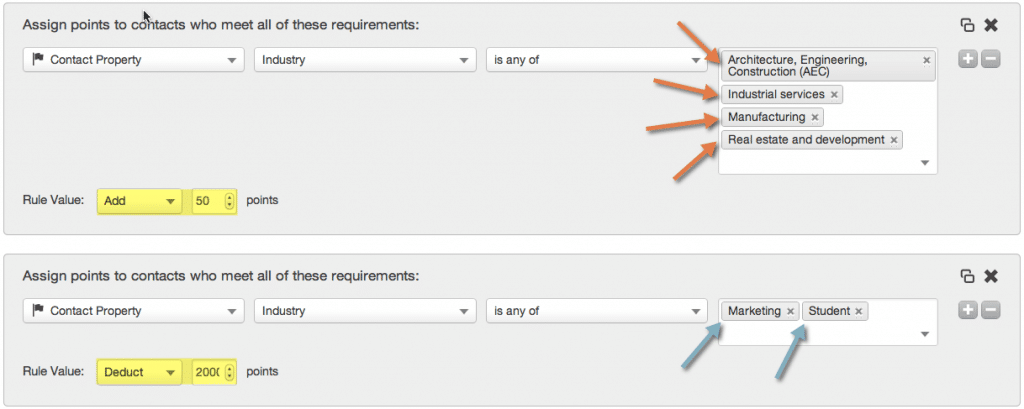A smart B2B website is designed to fill the sales funnel with leads. But when website lead generation starts working, data overload can set in. Your sales team can quickly become overwhelmed with the quantity of leads on the table and the challenge of approaching them all. So how can you help them pinpoint the leads worth pursuing?
This article is about implementing an automated lead-scoring system based on predetermined criteria, so you can evaluate which leads are ready for the sales process, which need more nurturing, and which don’t fit the bill at all. With this information in hand, your sales team – as big or small as it might be – can prioritize its time pursuing the best opportunities, while letting an automated marketing campaign simultaneously tend to the rest.
Segmenting leads by more than demographics
The information we can gather about leads captured on a B2B website now transcends simple demographics (industry, geography, job title, etc.). Today we have the ability to answer more insightful, behavioral questions about specific visitors, such as:
- How did they first discover you?
- Did they come and go quickly? Or did they dig around on your site for 20 minutes?
- Did they view your pricing page?
- What blog posts or services pages captured their interest the most?
- Have they opened the marketing emails you’ve sent them? What content in those emails did they click?
All of these bits of data are useful in their own way, but when you’re dealing with tens or hundreds of leads and a small sales team, the data needs to be harnessed to avoid paralysis in your sales process.
Enter lead scoring.
The purpose of lead scoring is to apply predetermined criteria about what defines a good lead to every new contact that comes in through your website. What results are manageable buckets of leads, marked as “qualified”, “maybe qualified” or “not qualified”. From here, actionable steps can take shape. Of course, to even start lead scoring you’ll need a website that’s built to attract and convert potential leads. Designing your own lead scoring system
Defining who you want to buy your products directs your whole lead-scoring strategy. When you can very specifically describe the traits of your ideal customer, it’s easy to assign points to good leads and bad leads.
So your first step is to answer the following questions for yourself:
- What industries are you targeting?
- How big is your ideal customer’s company? 10 people? 100? 50,000?
- Who at the company are you trying to reach? A purchasing agent? A project manager? The CEO?
- What products or services do your ideal customers typically seek?
- What are the biggest business pains these people experience?
Answers to these kinds of questions form the makeup of a qualified lead for your business. So if you can successfully collect this information from website visitors, you can score them accordingly.
Collecting information through a lead generation-centric website
We recently wrote a blog post about gathering intelligence on website leads and this topic is explained in much greater depth there. But the general idea follows.
If your website has been strategically architected as a B2B lead-generation tool, it’s much more than a brochure for your company. Instead, it’s a resource filled with valuable content that provides utility for your audience. Keyword-targeted blog posts attract a specific audience from search engines. Strategically-written calls-to-action throughout the site prompt visitors to download free white papers, case studies, buyer’s guides and other resources. And visitors are asked to “pay” for this content by providing bits of information about themselves that answer the previously-posed questions. This information is in turn added to their profile in your marketing database, and the lead scoring can begin.
Automating the lead-scoring process
At Gorilla, we streamline the lead-scoring process by integrating a marketing-automation software called Hubspot. This software lets our clients integrate their website forms directly into their marketing database. Once website visitors have answered questions and provided demographic information, we’re able to track their activity on the site and store that data in their profile.
We’re at work for our clients developing blog content and white papers, designing and implementing lead capture pages, and nurturing contacts through email marketing. A marketing-automation system is simultaneously busy filtering through data on new leads, assigning points to them, and grouping them into “qualified”, “maybe qualified and “not qualified” buckets. Our clients take these filtered buckets of qualified leads and follow up to turn them into face-to-face interactions and real customers.
It sounds complicated
This idea of lead scoring might sound intimidating, but it’s not as complicated as it might seem. Whether you’d consider implementing a marketing-automation software now, later or never, it’s worth understanding what an incredibly huge asset this can be for both your marketing and sales processes. Let’s look at an example.
A real-life example of automated lead scoring
At Gorilla, we’ve practiced what we preach when it comes to lead scoring. Below are examples pulled from our own marketing-automation software that illustrate how we’ve assigned points to leads.
Lead scoring by demographic information
Because at Gorilla we work best with industrial companies (we wrote the complete guide to industrial marketing), below we’ve assigned 50 points to anyone who has indicated in a website form that his or her business fits into any of the following industries: Architecture, Engineering, Construction, Industrial Services, Manufacturing, or Real Estate and Development. These 50 points are also assigned to any leads who we manually mark as being a part of one of these industries.
Simultaneously, for anyone who has indicated they’re in the marketing industry or a student, we’ve deducted 2000 points. Note that this doesn’t mean we don’t want them as followers! Rather, our lead-scoring system is designed to flag those visitors who might be ideal customers.

Lead scoring by interests
Because the primary service we offer at Gorilla 76 is a full-service marketing retainer, we want to flag anyone who indicates an interest in exactly that. Our website forms therefore ask visitors if they’re interested in such a retainer (as oppose to a website build or other services) and assign 200 points if so.

Lead scoring by level of engagement on our website
Moving beyond demographics, we assign points to leads based on their engagement on our website. Below, we assign points when visitors have returned to our site 4 or more times, and also when they’ve viewed 5 or more pages. Our marketing-automation system is able to track any specific visitor’s activity moving forward as long as he or she at some point in time filled out a form on our website.

Similarly, we assign points for engagement based on whether or not a lead has opened and clicked links in our marketing emails.

Lead scoring by specific actions taken
While engagement is a great way to measure interest, we also pinpoint specific actions taken by website visitors that help identify their needs. Here, we assign points when a visitor downloads one of our white papers or subscribes to our newsletter.

The end product: lists of segmented leads
In the end – once our automated lead-scoring system has done its work – we’re left with manageable, segmented lists of leads. Anyone with a lead score of 100 or higher is automatically dumped into our “marketing qualified” list. As you can see below, this list is made up of 63 people – a very manageable number.

Our final step is to manually sort through this “marketing qualified” list and mark the best leads as “sales qualified”. We’ll contact them directly. The rest we leave in this “marketing qualified” list and trigger automated email workflows to continue nurturing them until they’re more primed to make a buying decision.
Automated lead scoring is just one aspect of making your website a business tool. For the complete, 28-page guide to developing your business online, download our Tactical Guide to Industrial Lead Generation.
